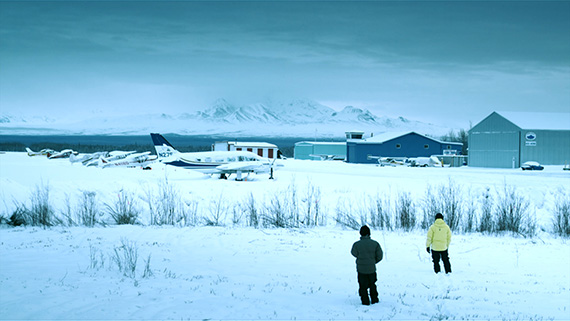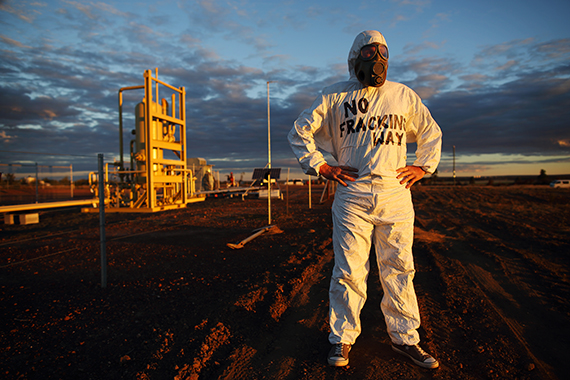For GOMA Turns 10, the Gallery’s Australian Cinémathèque presents an international program of films that explore how we see, feel about and use the natural world. Cinematically spectacular and emotionally charged, these films will stay with you long after the credits have rolled. This Land is Mine | This Land is Me screens at GOMA until 26 February 2017
Written for the Australian film One Night the Moon 2001, ‘This land is mine’ by musicians Paul Kelly and Kev Carmody plays out the differing perspectives of two characters and their connection to the same piece of land. Kelly, as the white settler, sings of his toil, farming the land (‘I’m working hard just to make it pay’), while Carmody, as an Indigenous tracker, sings of his sacred, abiding connection to the land (‘This land owns me, from generations past to infinity’). Their voices come together to sing the same line: ‘They won’t take it away from me’. This special GOMA Turns 10 film program considers the human right to land and its use, presenting stories of the human experience of nature across four interweaving strands that explore some of the ways in which nature has been characterised in art and cinema.
‘Connection’ showcases the relationship between humans and their immediate environment and the way landscape influences the bonds we forge with each other. In this group of films, the natural world creates a spaciousness that allows for the characters to experience a deepening connection to self, to each other and the land.
 Production still from Tropical Malady 2004 / Dir: Aphicatpong Weerasethakul
Production still from Tropical Malady 2004 / Dir: Aphicatpong Weerasethakul
Thai filmmaker Apichatpong Weeasethakul’s film Sud Pralad (Tropical Malady) 2004 is pervaded by jungle. This two-part narrative is a gentle love story that becomes a surreal exploration of the natural spirit. Moving away from the usual characterisation of wilderness as a threat, Weerasethakul’s jungle (while not benign) is a place of reflection and retreat as well as the home of the spirit, who appears in the form of a tiger; the filmmaker often blurs the natural and the spiritual, giving them equal weight. Tarva Yeghanaknere (The Seasons of the Year) 1975, by Armenian director Artavard Pelechian, is an exhilarating piece of cinema, shot mostly in agricultural settings. Rarely shown on the big screen, and with minimal dialogue, the film expresses the grandeur of the natural world and focuses on the connection between animal, human and environment. We see clouds rolling across the sky, farmers sliding hay bales down impossibly steep slopes, and a daring white-water rescue of farmer and sheep from a gushing stream. Through his beautiful framing and rhythmic montages, Pelechian elevates these from simple scenes to articulations of humanity as understood through landscape.
The films in ‘Transition’ focus on formidable landscapes that affect the people moving through them. This strand includes migration and the vastness of place.
 Production still from The Nine Muses 2010 / Dir: John Akomfrah / Image courtesy: Smoking Dogs Films
Production still from The Nine Muses 2010 / Dir: John Akomfrah / Image courtesy: Smoking Dogs Films
John Akomfrah’s The Nine Muses 2010 and Gianfranco Rosi’s documentary Fuocoammare (Fire at Sea) 2016 both examine the impact of landscape on migrants. The latter film captures life on Lampedusa, an island off the Sicilian coast, home to a small fishing community; it is also on the frontline of the European refugee crisis. The sea, which is a powerful metaphor in many of the films in this program, is constant here as both the bearer of traumatised, hopeful people and as an essential source of livelihood. Fire at Sea recently won the Golden Bear — the Berlin Film Festival’s highest prize. In contrast to these documentaries, North American auteur Gus Van Sant’s Gerry 2002 shows us two young men (Matt Damon and Casey Affleck) who set out for a walk in the desert and lose their way. What begins as a light-hearted adventure gives way to frustration and the slow realisation of the magnitude of their predicament. They trudge across rocky, sandy surfaces looking for the way back, while Van Sant’s landscape remains austere and impartial. With minimal dialogue, the film’s strength lies in its confidence in this pared-back performance, which leaves room for a deeper awareness of the self in relation to the landscape, for the characters and perhaps for the audience as well. ‘Conflict and Consequence’ explores tensions involving the natural world, including humanity’s domination of the environment (to its detriment and our own) and the struggles of land ownership, contested resources and land rights. This strand of films also investigates our anxieties about an uncertain future due to environmental imbalance, and the experiences of people already living with the consequences of climate change.
 Production still from Mad Max: Fury Road 2015 / Dir: George Miller / Image courtesy: Roadshow Entertainment
Production still from Mad Max: Fury Road 2015 / Dir: George Miller / Image courtesy: Roadshow Entertainment
Mad Max: Fury Road 2015 features in this strand for its engagement with contemporary environmental concerns. The early Mad Max films (1979–85) are set in a world in which war and the scarcity of petroleum lead to societal collapse. Fury Road, however, tells the story of a tyrannical despot whose power is assured by his control of a desert community’s water supply, reflecting modern anxieties over climate change. In the film’s impoverished landscape, his wealth and status is measured by the propagation of edible plants. Continuing the exploration of environmental unease, Belgium’s La Cinquieme Saison (The Fifth Season) 2012 shows nature in revolt: in a small farming village, winter will not turn to spring. Driven by beautiful, symbolic imagery, such as a ritual mid-winter bonfire (which inexplicably fails to light), the film chronicles social unrest as nothing grows and food supplies begin to run low — a subtly surreal parable of climate change and environmental imbalance.
 Production still from Frackman 2015 / Dir: Richard Todd, Jonathan Stack / Image courtesy: Demand Films
Production still from Frackman 2015 / Dir: Richard Todd, Jonathan Stack / Image courtesy: Demand Films
As a counterpoint to the fictional stories of environmental disorder, this strand also features several documentaries that look at conflict and chart the many lives already affected by climate change. In Thule Tuvalu 2014, two communities at different ends of the earth tell of their firsthand experience of changing weather. In Thule, Northern Greenland, the ice is receding at such a rate that food sources are threatened, and in Tuvalu, rising sea levels are threatening homes. The split of Sudan into two countries — a heightened moment of contested land — is covered in the 2014 documentary We Come as Friends. Director Hubert Sauper captures the situation as it unfolds, during which the Sudanese must negotiate stakeholders (from North American evangelists and Sudanese warlords to Chinese miners and UN peacekeepers) to be part of a new nation, in a series of incredibly frank interviews, Closer to home, Frackman 2015 follows Australian landowner and ‘accidental activist’ Dayne Pratzky who is at the frontline of the coal seam gas industry’s ongoing and controversial use of land.
The final strand, ‘Revelation’, brings together films that use elements of the natural world to express the metaphysical and the ineffable. Nature provides a symbolic language for conveying the sublime or mysterious in narratives that examine our place in the material and spiritual worlds.
 Production still from Tree of Life 2011 / Dir: Terrence Malick / Image courtesy: Icon Film Distribution
Production still from Tree of Life 2011 / Dir: Terrence Malick / Image courtesy: Icon Film Distribution
 Production still from Spear 2015 / Dir: Stephen Page / Image courtesy: Arenamedia
Production still from Spear 2015 / Dir: Stephen Page / Image courtesy: Arenamedia
The radiant images of childhood play that open Terrence Malick’s Tree of Life 2011 are quickly shadowed by the news of a death. Malick saturates the screen with natural imagery: a distant flock of birds move in unison at sunset. He is known for using natural settings to reconcile his characters’ emotional, spiritual and social standing, and here, nature creates a stillness and spaciousness within the narrative that allows the viewer to reflect on and more deeply engage with the story. Returning to country is a pervasive theme in Spear 2015, the debut film from Australian choreographer Stephen Page. Depicted through dance, Page explores some of the trials faced by young Indigenous men today, highlighting the deep importance of place to one’s sense of self.
‘This Land is Mine | This Land is Me’ attempts to unpack how nature is represented in film. Consciously side-stepping the ‘nature as a threat to civilisation’ disaster movie, or as something that exists outside the human experience, the films in this program touch on themes relevant to our everyday lives, from the desire to understand our place in the world to migration and environmental imbalance — some of the most important issues of our time.
This is an extract from the Gallery’s Artlines magazine available from the Gallery Store and online. Keep up to date with the Gallery’s seasonal publication delivered each quarter to QAGOMA Members.
This Land is Mine | This Land is Me screens at GOMA until 26 February 2017
Continue the conversation online with #GOMA10 @qagoma
> Want to know what’s on at QAGOMA?
> Find out more about our exhibitions
> Sign up to QAGOMA Enews
Copyright © 2008
This feed is for personal, non-commercial use only.
The use of this feed on other websites breaches copyright. If this content is not in your news reader, it makes the page you are viewing an infringement of the copyright. (Digital Fingerprint:
)